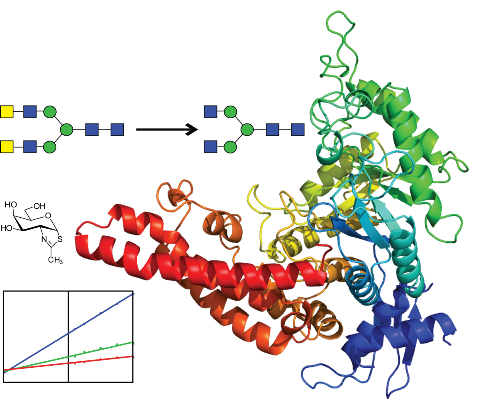Structure and Function of Hexosaminidases
SUPERVISOR: Iain WILSON
Background.
Hexosaminidases are a set of enzymes which degrade glycoconjugates, but which also in the Golgi of invertebrates have a role in determining the structure of N-glycans on secreted and cell surface glycoproteins; we have previously determined the in vitro enzymatic activity of a family of hexosaminidases from the model nematode C. elegans (Gutternigg et al., 2007; Dragosits et al., 2015).

Complementary to the ongoing FWF project in which C. elegans HEX-2 is being investigated (P29466), the goal in this thesis project would be to determine why C. elegans HEX-4 is specifically an N-acetylgalactosaminidase with the special property of being able to remove GalNAc from, e.g., GalNAcb1,4(ChoP6)GlcNAc motifs of phosphorylcholine-modified nematode glycans. Preliminary mass spectrometric data indicates that HEX-4 does have an impact on the N-glycome of C. elegans in vivo and that it has orthologues in some parasitic nematode species.
Aims and methods.
First, modelling of HEX-4 will be employed to examine which amino acids may play a role in its activity; also sequence alignments of homologous enzymes will be made in order to determine conserved residues. Thereafter, site-directed mutagenesis can be performed in a targeted manner and subsequent expression of wild-type and mutant forms HEX-4 in yeast will yield proteins for enzyme activity assays. Also, a large-scale amount of HEX-4 will be prepared for crystallisation trials, in which co-crystallisation with transition state inhibitors will also be attempted. In order to compare mechanistic details, the pH optima, Km values of GlcNAc and GalNAc-type substrates as well as the Ki values for hexosaminidase inhibitors such as NAG-thiazoline and GalNAc-thiazoline will be compared for the wild-type and mutant forms of HEX-4. Enzyme variants will also be tested with natural glycans from nematodes/insects in which the underlying GlcNAc is modified by either phosphorylcholine, phosphoethanolamime or fucose (Wilson & Paschinger, 2016; Stanton et al, 2017) to determine whether the status as a substrate is altered. The kinetic and any crystallisation results with HEX-4 will be compared with those for HEX-2 and considered in the context of N-glycomic data on hex-4 mutant worms lacking this enzyme. The primary methods will thereby be protein expression, enzyme assays, mass spectrometry and molecular modelling with the view of understanding a novel enzyme.
Collaborations within this thesis will include Chris OOSTENBRINK (modelling) and Diethard MATTANOVICH (large-scale yeast fermentation).
Dragosits, M., Yan, S., Razzazi-Fazeli, E., Wilson, I.B.H. and Rendić, D. (2015) Subtle differences in the substrate specificity of phylogenetically distinct invertebrate N-glycan processing hexosaminidases. Glycobiology 25, 448-464; doi:10.1093/glycob/cwu132
Gutternigg, M., Kretschmer-Lubich, D., Paschinger, K., Rendić, D., Hader, J., Geier,P., Ranftl, R., Jantsch, V., Lochnit, G., Wilson, I.B.H. (2007) Biosynthesis of truncated N-linked oligosaccharides results from non-orthologous hexosaminidase-mediated mechanisms in nematodes, plants and insects. J Biol Chem. 282, 27825-27840; doi: 10.1074/jbc.M602878200
Stanton, R., Hykollari, A., Eckmair, B., Malzl, D., Dragosits, M., Palmberger, D., Wang, P., Wilson, I.B.H., Paschinger, K. (2017) The underestimated N-glycomes of lepidopteran species. Biochimica et Biophysica Acta 1861, 699-714; doi: 10.1016/j.bbagen.2017.01.009
Wilson, I.B.H., Paschinger, K. (2016) Sweet secrets of a therapeutic worm: Mass spectrometric N-glycomic analysis of Trichuris suis. Anal Bioanal Chem, 408, 461-471; doi: 10.1007/s00216-015-9154-8
